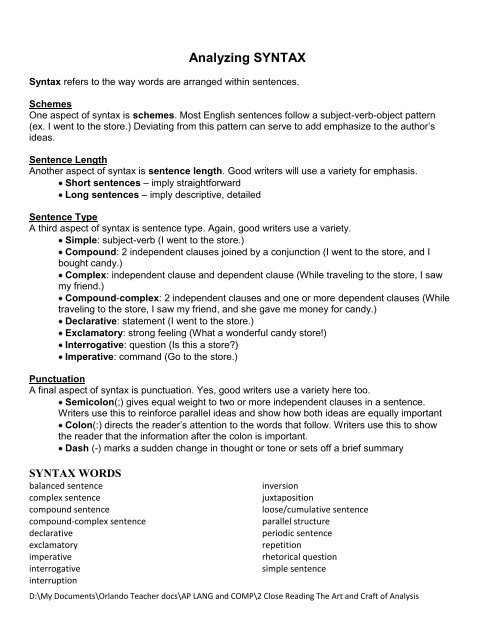How to write a rhetorical analysis essay
How to write a rhetorical analysis essay
How to write a rhetorical analysis essay
- No tags were found...
Create successful ePaper yourself
Turn your PDF publications into a flip-book with our unique Google optimized e-Paper software.
Analyzing SYNTAXSyntax refers <strong>to</strong> the way words are arranged within sentences.SchemesOne aspect of syntax is schemes. Most English sentences follow a subject-verb-object pattern(ex. I went <strong>to</strong> the s<strong>to</strong>re.) Deviating from this pattern can serve <strong>to</strong> add emphasize <strong>to</strong> the author’sideas.Sentence LengthAnother aspect of syntax is sentence length. Good <strong>write</strong>rs will use a variety for emphasis.Short sentences – imply straightforwardLong sentences – imply descriptive, detailedSentence TypeA third aspect of syntax is sentence type. Again, good <strong>write</strong>rs use a variety.Simple: subject-verb (I went <strong>to</strong> the s<strong>to</strong>re.)Compound: 2 independent clauses joined by a conjunction (I went <strong>to</strong> the s<strong>to</strong>re, and Ibought candy.)Complex: independent clause and dependent clause (While traveling <strong>to</strong> the s<strong>to</strong>re, I sawmy friend.)Compound-complex: 2 independent clauses and one or more dependent clauses (Whiletraveling <strong>to</strong> the s<strong>to</strong>re, I saw my friend, and she gave me money for candy.)Declarative: statement (I went <strong>to</strong> the s<strong>to</strong>re.)Exclama<strong>to</strong>ry: strong feeling (What a wonderful candy s<strong>to</strong>re!)Interrogative: question (Is this a s<strong>to</strong>re?)Imperative: command (Go <strong>to</strong> the s<strong>to</strong>re.)PunctuationA final aspect of syntax is punctuation. Yes, good <strong>write</strong>rs use a variety here <strong>to</strong>o.Semicolon(;) gives equal weight <strong>to</strong> two or more independent clauses in a sentence.Writers use this <strong>to</strong> reinforce parallel ideas and show how both ideas are equally importantColon(:) directs the reader’s attention <strong>to</strong> the words that follow. Writers use this <strong>to</strong> showthe reader that the information after the colon is important.Dash (-) marks a sudden change in thought or <strong>to</strong>ne or sets off a brief summarySYNTAX WORDSbalanced sentencecomplex sentencecompound sentencecompound-complex sentencedeclarativeexclama<strong>to</strong>ryimperativeinterrogativeinterruptioninversionjuxtapositionloose/cumulative sentenceparallel structureperiodic sentencerepetitionrhe<strong>to</strong>rical questionsimple sentenceD:\My Documents\Orlando Teacher docs\AP LANG and COMP\2 Close Reading The Art and Craft of Analysis
















